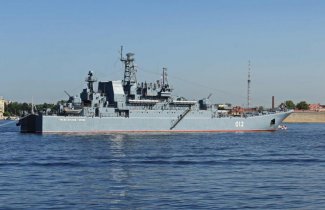Ukrainian drones attack the base at Novorossiysk. Day 526 of the war

On the night of 4 August, Ukrainian surface kamikaze drones attacked the Russian naval base in Novorossiysk. One of them damaged the landing ship Oleniegorskiy Gorniak, which had been diverted from the Northern Fleet to the Black Sea to participate in the so-called special military operation. The action was carried out by the Security Services of Ukraine (SBU) in cooperation with the Ukrainian navy. At the same time, Ukrainian drones attacked facilities in Crimea from the air; according to some sources, a fuel depot near Feodosiya was hit. The Russian side reported the destruction of two drones in Novorossiysk and all of the 13 sent to Crimea. The previous day, the Russians reported shooting down a total of seven Ukrainian drones in the Kaluga region of the Russian Federation. On 2 August, Gvardeyskoe airport near Simferopol was the target of a Ukrainian missile attack, but no damage was confirmed.
On 2 August, Russian kamikaze drones attacked the Ukrainian port of Izmail at the mouth of the Danube, damaging the infrastructure (including fuel tanks at one of the transhipment terminals and an elevator storing 40,000 tonnes of grain) and ultimately halting the port’s operations. On the same day, it was reported that more than 10 drones were shot down in Kyiv; shrapnel fell in three areas of the city and four buildings were damaged. The Ukrainian Air Force Command reported that a total of 23 enemy Shahed-136/131 drones were shot down that day; in his customary evening speech President Volodymyr Zelenski reported that the Russians had used 37 of these drones in the attack. In addition, the Russians used missiles from S-300 systems to attack Slavyansk (five missiles fell on the town’s outskirts) and Pershotrvaneve in Kharkiv oblast. The day before, Russian missiles targeted Tavriyske in Zaporizhzhia oblast, and on 3 August they struck Avdiivka, where an industrial facility was reportedly damaged. On 3 August, the Russians also renewed their drone attacks on Kyiv; the Ukrainian Air Force Command declared that all 15 of the Shahed-136/131s used had been shot down.
Russian forces reportedly made slight advances north-east of Kupyansk, on the border of Luhansk and Kharkiv oblasts, and south-east of the town of Kreminna. Successive attacks by the invaders in the areas of Bakhmut, Avdiivka, Mariinka and (as reported by the Ukrainian General Staff) south of Velyka Novosilka failed to bring about any changes. The series of Ukrainian attacks south of Orikhiv and south-west of Bakhmut were also unsuccessful, as were attempts to eliminate Russian bridgeheads on the west bank of the Zherebets river. On 2 August, Ukrainian General Staff spokesman Pavlo Kovalchuk reported that the invaders’ forces had been pushed out of their positions south of Avdiivka. Meanwhile on 4 August Colonel Serhiy Kuzmin, the deputy commander of the Ukrainian Taurida operational-strategic grouping, reported on the progress of the defenders in the area around Vuhledar. The previous day, Kuzmin had given an update on the position of the Russian troops on the southern section of the front. A grouping of 150,000 troops is reportedly operating there; its core is made up of units from the three combined arms armies of the Eastern Military District (the 5th, 35th and 36th Armies) and the 58th Combined Arms Army of the Southern Military District.
On 4 August, Ukrainian Air Force Command spokesman Colonel Yuri Ihnat announced that at the end of the summer, Ukrainian pilots would begin going to European countries for “serious training”. He pointed out that they would need up to six months to master the F-16s.
President Zelensky said on 3 August that the Russians had used at least 1961 Shahed 136/131 drones against Ukraine since last summer, most of which had been shot down by Ukrainian air defences.
On 3 August, Prime Minister Denys Shmyhal announced that it was costing almost 2 trillion hryvnias ($54 billion) to maintain the Ukrainian Armed Forces and prosecute the war, a sum which exceeds the entire budget’s peacetime revenues (1.3 trillion hryvnias). Since 24 February 2022, Ukraine is estimated to have lost 30% of its economy and businesses as well as 3.5 million jobs, and its GDP is calculated as having fallen by 29.5%. Shmyhal stressed that the state is being sustained by financial support from partners, grants and loans. Meanwhile, on 4 August Reuters reported that Russian military budget spending in 2023 has so far reached more than $100 billion, accounting for 37.3% of total spending. Russia planned to spend 4.98 trillion roubles (over $52 billion, 17.1 per cent of budget expenditure) on defence this year, and has spent 5.59 trillion roubles in the first six months alone.
Citing data from the Ministry of Defence of the Russian Federation, Deputy Chairman of the Security Council of the Russian Federation Dmitry Medvedev said that at least 231,000 people had signed a contract with the MO of the Russian Federation from 1 January to 3 August 2023. However, he did not provide any details concerning the individuals who had signed these contracts.
Commentary
- The damage to the landing ship Oleniegorskiy Gorniak probably represents the biggest success for Ukrainian surface drone attacks to date. The circumstances and results of the Ukrainian attack on the Sevastopol base last October remain unclear (the minesweeper Ivan Golubets was set on fire, but the report of damage to the frigate Admiral Makarov was not confirmed). So far this year, the only strike confirmed was on the reconnaissance ship Ivan Khurs in May; the vessel was damaged and forced to return to the Sevastopol base. In the vast majority of cases, the Russian side has reported destroying enemy drones with onboard weapons before they reach their targets. These ‘drones’ are actually high-speed motor boats filled with explosives, which are built in Ukraine with Western components. Most recently (1 August), the missile corvettes Vasily Bykov and Sergey Kotov (these are Kalibr missile carriers, which in Russian nomenclature are referred to as patrol vessels) were attacked unsuccessfully. However, the Ukrainian Naval Command denied involvement in the attack, and its spokesperson even stated that the Ukrainian fleet does not have the surface drones it would need to carry out such attacks.
- Although Ukrainian surface drones have so far had only sporadic success, the very possibility of their use deprives the Russians of the full freedom to operate in the Black Sea, and has forced them to keep a close watch on the sea’s surface. The invaders have also been forced to introduce additional coastal infrastructure protection in the form of floating barriers on the approaches to the port of Sevastopol and the bridge over the Kerch Strait. The Russians have so far not anticipated an attack on Novorossiysk, which is at the far limit of the Ukrainian surface kamikaze drones’ range.
- It is certain that the figure of 231,000 people who have signed contracts with the Russian defence ministry in 2023 does not only refer to new volunteers from ‘civilian life’ who wish to join the ranks of the army. This is because some of those who have been subjected to forced mobilisation chose to sign a contract for professional service in the army, which gives them additional privileges. Another group of these ‘new recruits’ consists of soldiers conscripted from the drafts last autumn and this spring who switched to professional service after enlistment. In recent months the Russian defence ministry has also signed contracts with prisoners and soldiers of so-called private military companies, including a small proportion of Wagner Group soldiers.





